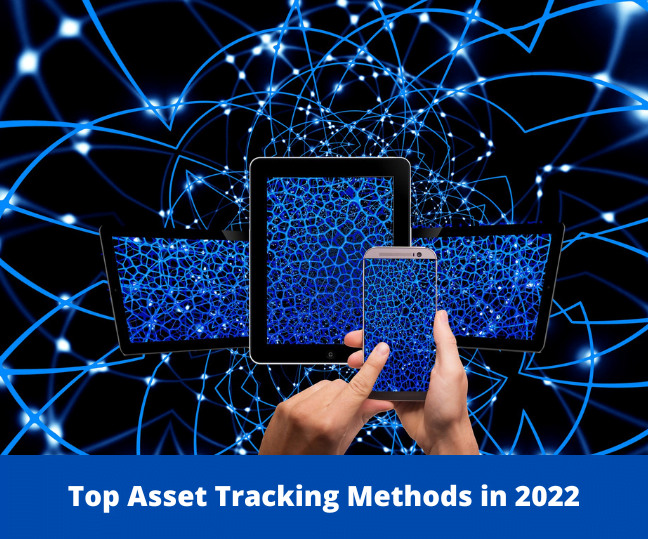The issue of losing assets affects everyone. For many firms, it’s also expensive because missing goods and equipment translate into missed sales. Asset tracking can help with this. The issue is that it can be challenging to select the best asset tracking system.
You must make the most of every asset because doing so will enable you to save money. Firms can reduce their total cost of ownership and increase their asset return on investment by identifying their assets at the right moment. It is crucial here to test out digital transformation services.
You can find the method you’re looking for among the top 7 asset monitoring methods included in this blog, commonly utilized by businesses in various sectors.

Most Common Asset Tracking Methods:
Related Articles: Asset Tagging : What it is & Why is it Important
Barcodes Asset Tracking:
It is a cheap, incredibly portable, lightweight device that may be utilized anywhere for your business. There is no theoretical cap on the number of assets that can be accounted for using it. Many businesses use bar codes to monitor the assets from one location to another because they are reasonably easy to use. Bar codes are a wise choice due to their cost effectiveness and lack of user training.
Despite their usefulness, barcodes aren’t always the best asset-tracking method. Barcodes don’t automatically display location or real-time status. The identification from the most recent scan is what they do display. This means that some location information must accompany scanning to properly know where assets are or were when scanned, at least.
QR Code Asset Tracking:
The QR code is growing in popularity. It is a developed form of the barcode. Since the invention of the barcode, this concept has largely remained unchanged: Physical items are given the barcode that identifies them, and a system of barcode scans records whatever checkpoints are required. It is shaped like a square and a rectangle with black pixels in place of bars. Once more, even a mobile phone scanner can read it.
QR Codes are now globally standardized and can be easily encrypted. It generally requires no employee training and can be more easily readable than barcodes. It is beneficial in various ways, including quick information transfer, GPS tracking, and many layers of error correction in the event of damage or obstruction.
Although it has numerous benefits, it also has some drawbacks, such as being more expensive than a barcode scanner, having a shorter range, inconsistent printing that results in illegible render code, and poor reading in low light.
Radio Frequency Identification (RFID) Asset Tracking:
Barcode technology and RFID technology are nearly identical. However, compared to a barcode scanner, RFID operates more quickly. RFID systems generally use electromagnetic scanners and tags in their operation. To keep track of product information, it employs radio waves. It makes digital data in RFID tags possible.
The product information of the assets is transmitted via radio waves. The data is digitally encoded and stored in RFID tags attached to the product. Readers, sometimes known as interrogators, identify the tags that are present. The reading procedure recognizes the tags most often, but this scan can also yield other information. Like a barcode, this information must be read by a scanner device, but it has the advantage that there are no alignment mistakes.
In RFID, a reader device collects data from a tag and sends it to be stored in a database. Since RFID has a waterproof layer for security, it is more secure. RFID has the drawback that information cannot be read from a tag unless the reader or scanner touches it.
Bluetooth (BLE) Asset Tracking
One of the most popular technologies for asset tracking and other indoor locating applications is Bluetooth. Since its inception, Bluetooth Low Energy (BLE) has relished a significant advantage over less recent technologies like Wi-Fi and GPS due to its low power requirements.
Typically, BLE systems create their wireless networks using a mix of Beacon and Hub devices. Incorporating mobile Bluetooth-enabled devices, such as smartphones, into many BLE solutions makes implementation easier. BLE is a prevalent technology for location and tracking applications due to the capability of using consumer mobile devices as roaming hubs. Hospitals and other indoor settings like shopping centers frequently employ BLE to collect location information.
Latency is a key drawback for BLE. Signal interference is a common problem because many devices are currently vying for the same radio frequency band as BLE. As a result, a BLE system may have reduced speed, dropped data points, and lost coverage.
Related Articles: Best practices for effective asset tagging in 2022
GPS (Global Positioning System) Asset Tracking:
GPS relies on a system of in-orbit satellites that can pinpoint each other’s locations and precisely synchronize their clocks. It lets users track the asset’s precise positioning and relative motion tracking.
Numerous organizations also make great efforts to improve the reliability and usability of GPS. Multiple reliable mobile apps, GPS-enabled wearables, and deployable gadgets have emerged due to GPS’s widespread usage. Because end users are not responsible for the maintenance of the satellite systems, GPS also has the benefit of minimal infrastructure costs, often charging for the tracked gear itself or gateway devices in some circumstances.
GPS’s accuracy can also be lacking; the most exact measurements it can make without a complicated differential GPS are between 5 and 10 meters. Due to front-end data manipulation used by navigation apps, your phone may occasionally appear you are on one route while you are traveling parallel to it. Scaling GPS solutions to smaller assets may not be practical because of the precision restrictions. However, GPS is still more than accurate enough to help track huge assets that are in motion outdoors.
NFC (Near Field Communication) Asset Tracking:
In essence, NFC and RFID are comparable in operation. An improved version of the RFID device is the NFC device. It would be best if you had no special scanning equipment to keep track of your inventory and assets. You can track assets using your smartphone. Its range, though, is merely a few inches.
As a result, you must remain close to the asset or inventory to use it. Bring the device close, and it will read automatically without needing to be focused. NFC processes quickly, making it incredibly rapid and effective. It also has the benefit of being able to converse with a mobile device, and because of this, reading it through a mobile app is simple and does not require an RFID reader.
Wi-Fi Asset Tracking:
Wi-Fi has many distinctive advantages as an asset monitoring system, including widespread adoption, industry recognition, a wide range of standards, and many Wi-Fi-capable devices already in use.
Wi-Fi, like BLE, mainly uses RSSI algorithms to find and track objects. It involves using historical RSSI in a technique known as fingerprinting, which improves the reliability of location systems but typically increases preparation and transmitter density costs. Some Wi-Fi systems can also use AoA and ToF measurements, like BLE and UWB. However, these may call for a more complicated initial setup and calibration.

Even while using fingerprinting or AoA / ToF measurements with Wi-Fi is technically challenging, the technology’s widespread use can help ease many systems’ implementation processes. For instance, Wi-Fi is already used by businesses and individuals to send many types of data. It indicates that Wi-Fi tracking solutions frequently require fewer data bridging techniques.
In wireless technology using RSSI, accuracy and dependability are frequent problems. Positioning can be achieved within a few meters, but accuracy is frequently hampered by moving objects or other obstructions. Solutions are challenging to scale because of Wi-Fi asset tracking’s typical fickle nature. Additionally, it makes Wi-Fi unsuitable for many situations or usage, such as surroundings with many actively moving elements.
Final Thoughts:
Asset tracking can be done using each of these techniques! There is a technique of tracking and comprehending your assets that is ideal for you thanks to these technological advancements, whether you work with a small workplace or a larger workspace throughout the globe. It immediately informs you of your assets’ location and present condition.
Asset optimization and asset tracking are both beneficial. Asset tracking prevents asset loss or theft and provides excellent customer service. Most likely, every product in the world of tomorrow will have some form of identity. Consequently, there will be a paradigm shift in how asset management and asset tracking are done.





















